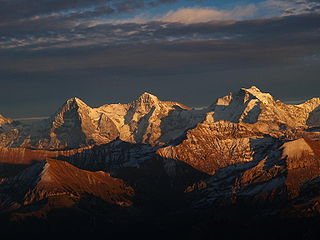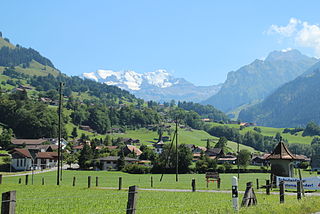Swiss German is any of the Alemannic dialects spoken in the German-speaking part of Switzerland and in some Alpine communities in Northern Italy bordering Switzerland. Occasionally, the Alemannic dialects spoken in other countries are grouped together with Swiss German as well, especially the dialects of Liechtenstein and Austrian Vorarlberg, which are closely associated to Switzerland's.

The Bernese Mountain Dog is a large-sized breed of dog, one of the four breeds of Sennenhund-type dogs from the Swiss Alps. The name Sennenhund is derived from the German Senne and Hund (hound/dog), as they accompanied the alpine herders and dairymen called Senn. Berner refers to the area of the breed’s origin, in the canton of Bern. This mountain dog was originally kept as a general farm dog. Large Sennenhunde in the past were also used as draft animals, pulling carts. The breed was officially established in 1907. In 1937, the American Kennel Club recognized it; today, the club classifies it as a member of the Working Group.
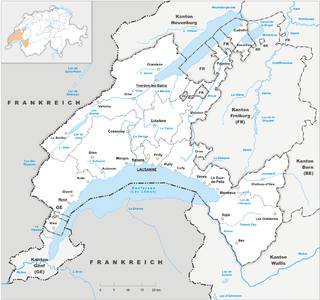
The canton of Vaud is the third largest of the Swiss cantons by population and fourth by size. It is located in Romandy, the French-speaking western part of the country; and borders the canton of Neuchâtel to the north, the cantons of Fribourg and Bern to the east, Valais and Lake Geneva to the south, the canton of Geneva to the south-west and France to the west.

The canton of Bern or Berne is the second largest of the 26 Swiss cantons by both surface area and population. Located in west-central Switzerland, it borders the canton of Jura and the canton of Solothurn to the north. To the west lie the canton of Neuchâtel, the canton of Fribourg and canton of Vaud. To the south lies the canton of Valais. East of the canton of Bern lie the cantons of Uri, Nidwalden, Obwalden, Lucerne and Aargau.

Berner Sport Club Young Boys is a Swiss sports club based in the capital city Bern. It is widely referred to as Young Boys, or as Young Boys Bern abroad, and is abbreviated to YB. The club's colors are yellow and black.

Romandy is the French-speaking part of western Switzerland. In 2010, about 1.9 million people, or 24.4% of the Swiss population, lived in Romandy. The bulk of the romand population lives in the Arc Lémanique region along Lake Geneva, connecting Geneva, Vaud and the Lower Valais.
Bernese German is the dialect of High Alemannic German spoken in the Swiss plateau (Mittelland) part of the canton of Bern and in some neighbouring regions. A form of Bernese German is spoken by the Swiss Amish affiliation of the Old Order Amish in Adams County, Indiana, United States and their daughter settlements.

The Berner Oberland, is the higher part of the canton of Bern, Switzerland, in the southern end of the canton, and one of the canton's five administrative regions.
This article is about the phonology of Bernese German. It deals with current phonology and phonetics, including geographical variants. Like other High Alemannic varieties, it has a two-way contrast in plosives and fricatives that is not based on voicing, but on length. The absence of voice in plosives and fricatives is typical for all High German varieties, but many of them have no two-way contrast due to general lenition.
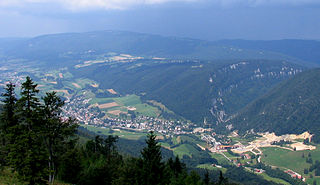
Bernese Jura is the name for the French-speaking area of the Swiss canton of Bern, and from 2010 one of ten administrative divisions of the canton.

The Battle of Laupen was fought on June 21, 1339 between Bern and its allies on one side, and Freiburg together with feudal landholders from the County of Burgundy and Habsburg territories on the other. Bern was victorious, consolidating its position in the region. As a consequence of the conflict, the relations of Bern and the Swiss Confederacy tightened, resulting in Bern's permanent accession in 1353.

Léman was the name of a canton of the Helvetic Republic from 1798 to 1803, corresponding to the territory of modern Vaud. As a former subject territory of Bern, Vaud had been independent for only four months in 1798 as the Lemanic Republic before it was incorporated in the centralist Helvetic Republic. Léman comprised all of the Vaud detached from Bernese occupation, apart from the Avenches and the Payerne which, after 16 October 1802, were annexed by the canton of Fribourg until the Napoleonic Act of Mediation the following year, when they were restored to the newly established and newly sovereign canton of Vaud.

The city of Bern, founded in 1191 and first mentioned in a document in 1208, grew to become the biggest aristocratic city-state north of the Alps and a major power in the Old Swiss Confederacy. The former extent of Bern included the cantons of Bern, Vaud and large parts of Aargau.

Tourists are drawn to Switzerland's diverse landscape as well as activities. Most interesting are the Alpine climate and landscapes, in particular for skiing and mountaineering.

Melchior Anderegg, from Zaun, Meiringen, was a Swiss mountain guide and the first ascensionist of many prominent mountains in the western Alps during the golden and silver ages of alpinism. His clients were mostly British, the most famous of whom was Leslie Stephen, the writer, critic and mountaineer; Anderegg also climbed extensively with members of the Walker family, including Horace Walker and Lucy Walker, and with Florence Crauford Grove. His cousin Jakob Anderegg was also a well-known guide.
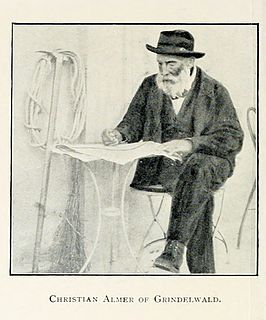
Christian Almer was a Swiss mountain guide and the first ascentionist of many prominent mountains in the western Alps during the golden and silver ages of alpinism.
The 2012 International Bernese Ladies Cup was held from January 13 to 15 at the Curlingbahn Allmend in Bern, Switzerland as part of the 2011–12 World Curling Tour. The winning team of Michèle Jäggi took home the event purse of CHF20,000. The event was held in a triple-knockout format.

The Battle of Grauholz on 5 March 1798 was a battle between a Bernese army under Karl Ludwig von Erlach against the French Revolutionary Army under Balthazar Alexis Henri Schauenburg. The battle took place at Grauholz, a wooded hill in what is now the municipalities of Urtenen-Schönbühl and Moosseedorf in the canton of Bern in Switzerland. The government of Bern had already surrendered the previous day and the Bernese defeat at Grauholz ended their resistance to the French in the north of the canton.
The 2014 International Bernese Ladies Cup was held from January 10 to 12 at the Curlingbahn Allmend in Bern, Switzerland as part of the 2013–14 World Curling Tour. The event was held in a triple-knockout format, and the purse for the event was CHF 20,500, of which the winner, Eve Muirhead, received CHF 6,000. Muirhead defeated Anna Sidorova of Russia in the final with a score of 6–3.

